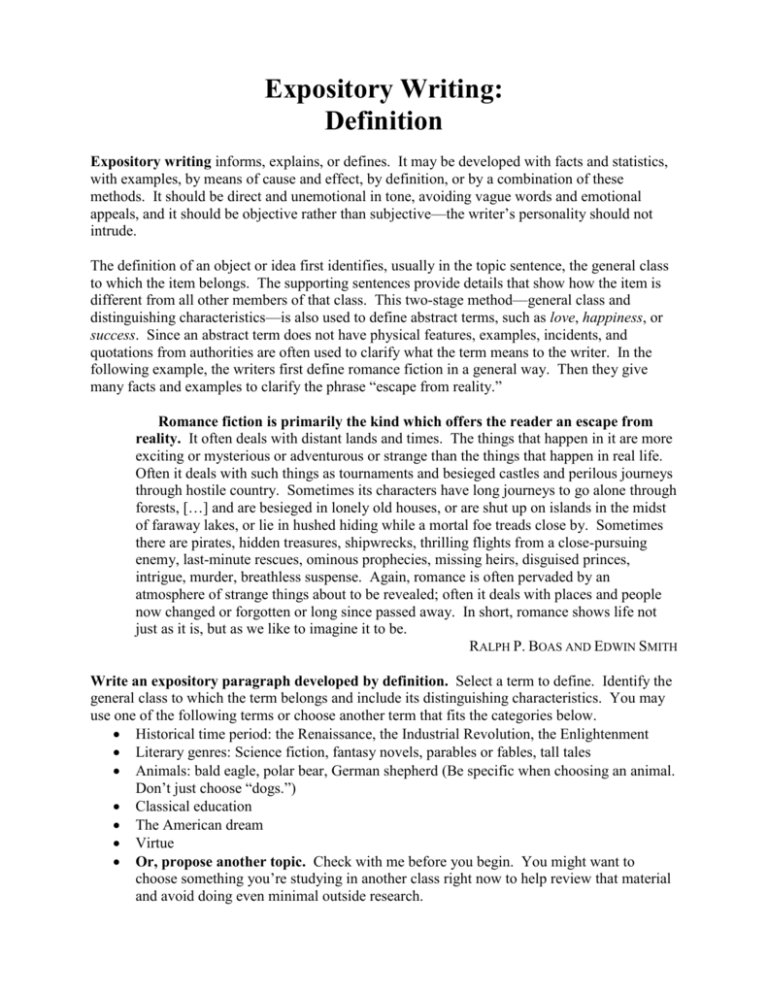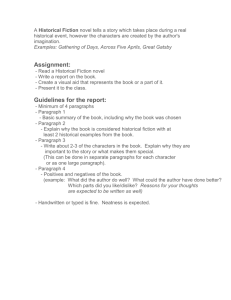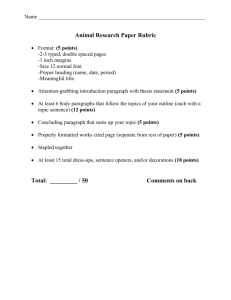Expository-Writing-Definition
advertisement

Expository Writing: Definition Expository writing informs, explains, or defines. It may be developed with facts and statistics, with examples, by means of cause and effect, by definition, or by a combination of these methods. It should be direct and unemotional in tone, avoiding vague words and emotional appeals, and it should be objective rather than subjective—the writer’s personality should not intrude. The definition of an object or idea first identifies, usually in the topic sentence, the general class to which the item belongs. The supporting sentences provide details that show how the item is different from all other members of that class. This two-stage method—general class and distinguishing characteristics—is also used to define abstract terms, such as love, happiness, or success. Since an abstract term does not have physical features, examples, incidents, and quotations from authorities are often used to clarify what the term means to the writer. In the following example, the writers first define romance fiction in a general way. Then they give many facts and examples to clarify the phrase “escape from reality.” Romance fiction is primarily the kind which offers the reader an escape from reality. It often deals with distant lands and times. The things that happen in it are more exciting or mysterious or adventurous or strange than the things that happen in real life. Often it deals with such things as tournaments and besieged castles and perilous journeys through hostile country. Sometimes its characters have long journeys to go alone through forests, […] and are besieged in lonely old houses, or are shut up on islands in the midst of faraway lakes, or lie in hushed hiding while a mortal foe treads close by. Sometimes there are pirates, hidden treasures, shipwrecks, thrilling flights from a close-pursuing enemy, last-minute rescues, ominous prophecies, missing heirs, disguised princes, intrigue, murder, breathless suspense. Again, romance is often pervaded by an atmosphere of strange things about to be revealed; often it deals with places and people now changed or forgotten or long since passed away. In short, romance shows life not just as it is, but as we like to imagine it to be. RALPH P. BOAS AND EDWIN SMITH Write an expository paragraph developed by definition. Select a term to define. Identify the general class to which the term belongs and include its distinguishing characteristics. You may use one of the following terms or choose another term that fits the categories below. Historical time period: the Renaissance, the Industrial Revolution, the Enlightenment Literary genres: Science fiction, fantasy novels, parables or fables, tall tales Animals: bald eagle, polar bear, German shepherd (Be specific when choosing an animal. Don’t just choose “dogs.”) Classical education The American dream Virtue Or, propose another topic. Check with me before you begin. You might want to choose something you’re studying in another class right now to help review that material and avoid doing even minimal outside research. Prewriting: Begin by naming the general class to which the term belongs. Then begin listing qualities of this term that make it different from other things belonging to that general class. For example, if you chose German shepherds as your topic, you would note that it is a dog. Then you would begin listing characteristics such as average size, coloring, temperament, etc. List as many qualities as you can. You may need to do a small bit of research, though you can avoid this by choosing a topic with which you are very familiar or which you are studying in another class. Then make a rough outline by selecting the most important features of the term and arranging them in an easy-to-follow order. Begin the paragraph with a topic sentence and develop it with the details you selected. Writing: As you write your first draft, keep your purpose—to inform—in mind. Be sure to include enough supporting information to make each example clear and interesting. For this assignment, your paragraph should be approximately 90-100 words long. Style Devices: Use each of the dress-ups and 4 different sentence openers (not including subject), highlighting and labeling as directed on the style device reference sheet. Evaluating and Revising: Ask yourself: Have I included enough features of the term to distinguish it from similar things? Have I described this features with precise, detailed language? Did I remain objective (for example, by avoiding the use of the first person)? Proofreading and Making a Final Copy: Proofread your paragraph carefully for spelling and punctuation errors. Check to see that you have included the style devices. Make a final copy, typing and double-spacing. Please highlight and label by hand. Make sure you have titled your paragraph.






